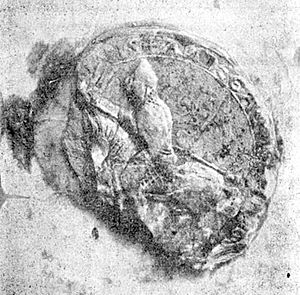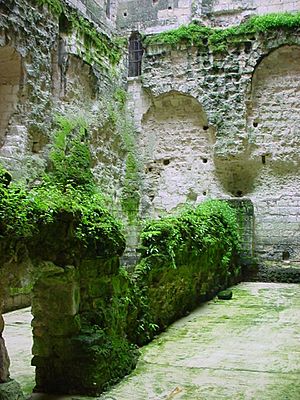Fulk III, Count of Anjou facts for kids
Quick facts for kids Fulk III, Count of Anjou |
|
|---|---|
 |
|
| Seal of Fulk III | |
| Spouse(s) | Elisabeth of Vendôme Hildegarde of Sundgau |
| Issue | |
| Adele of Vendome-Anjou Geoffrey II, Count of Anjou Ermengarde of Anjou, Duchess of Burgundy |
|
| Noble family | House of Ingelger |
| Father | Geoffrey I, Count of Anjou |
| Mother | Adelaide of Vermandois |
| Born | c. 987 |
| Died | 21 June 1040 (aged 69–70) Metz |
Fulk III, the Black (c. 987–1040), also known as Foulque Nerra in Old French, was an important count of Anjou. He is famous for being one of the first great builders of medieval castles. It's thought that Fulk built about 100 castles and many religious buildings called abbeys in the Loire Valley region of what is now France.
Fulk fought many wars against his neighbors in places like Brittany, Blois, Poitou, and Aquitaine. He also made four long journeys, called pilgrimages, to Jerusalem during his life. He had two wives and three children. Fulk was a skilled horseman and a strong warrior. He was very good at military strategy, which helped him win against most of his enemies. He supported the goals of the Capetians, who were a powerful family at the time.
Fulk's main rival was Odo II of Blois, whose lands were about 128 kilometers east of Fulk's main city, Angers. These two leaders often fought over towns and followers throughout their lives.
Contents
Building Castles
Fulk finished his first castle at Langeais, about 104 kilometers east of Angers. It was built on the banks of the Loire River. Many of Fulk's castles started as wooden towers. Later, these were replaced with strong stone buildings. These stone castles had thick outer walls and a tall, strong tower called a donjon (which is where the English word "dungeon" comes from, though a donjon was a tower, not a cellar).
Fulk built the Langeais castle in the territory of Odo I, Count of Blois. They fought a battle over it in 994. But Odo I suddenly died, and his son, Odo II, couldn't force Fulk out.
Fulk kept building more towers to slowly surround Tours, a city near Odo's lands. Some of these castles included Montbazon, Montrésor, Mirebeau, Montrichard, and Loches. In 1016, he even built a tower called Montboyau right across the Loire River from Tours. He also made the castles at Angers, Amboise, Chateau-Gontier, Chinon, Mayenne, and Semblançay much stronger. Building castles to expand his power was a key part of Fulk's plan.
Religious Life
Fulk was a very religious Christian. He built, made bigger, or gave money to several abbeys and monasteries. These included the Abbey of Beaulieu-lès-Loches, Saint-Florent-le-Vieil, Saint-Aubin, and a convent called Notre Dame de la Charité in Angers. Even though he never learned to write, he set up a school to help poor students get an education.
Fulk also went on four pilgrimages to Jerusalem. These were very long and dangerous journeys.
Family Life
Fulk was the son of Geoffrey I of Anjou, who was also known as Geoffrey Grisegonelle. His mother was Adele of Meaux. Fulk had an older sister named Hermengarde and a younger brother named Geoffrey. He also had a half-brother named Maurice.
Fulk married Elisabeth of Vendôme first. They had one daughter:
- Adèle: She married Bodon, who was the son of Landry, Count of Nevers. Their oldest son, Bouchard, later inherited Vendôme.
Around December 1005, Fulk married Hildegarde of Sundgau. She came from a family in Lorraine. They had two children:
- Geoffrey II: Born in 1006, he was known as Geoffrey Martel. He became Count of Anjou after Fulk died in 1040.
- Ermengarde-Blanche: Born around 1018.
Important Battles
Fulk Nerra's first big win was in June 992 at the Battle of Conquereuil. Here, he defeated Conan I, Duke of Brittany. Conan had tried to attack Angers while Fulk was away. But Fulk and his men stopped the attack, and Conan's son, Alain, was killed. In 992, Fulk attacked Conan's castle at Nantes. Conan escaped, but Fulk later killed him in battle. Fulk then put a governor in charge because the next count was a child.
Fulk and Odo II fought many small battles. Their biggest fight happened in July 1016 at the Battle of Pontlevoy. Odo marched 10,000 men towards Fulk's tower at Montboyau. Meanwhile, Fulk and his much smaller group attacked Odo from behind. Fulk's men were pushed back, and Odo thought he had won. He even went for a swim in the Cher River! But then, more of Fulk's allies, led by Count Herbert Wake-Dog of Maine, arrived. They surprised Odo's men and defeated them. Thousands of soldiers were reported killed.
Journeys to Jerusalem
Fulk made four long journeys to Jerusalem. His first two trips, in 1003 and 1008, were to ask for forgiveness for his actions. For example, after Fulk was punished by the king for a serious act against an enemy, he was required to go on a pilgrimage.
His third and fourth trips were different. After Jerusalem was damaged by a ruler called "Mad Caliph" Al-Hakim bi-Amr Allah, Fulk felt he had to protect other travelers. So, in 1035 (with Robert I, Duke of Normandy) and 1038, he provided armed guards for pilgrims to keep them safe from robbers and attackers.
Fulk died in Metz in 1040 on his way back from his last trip. He was buried in the chapel of his monastery at Beaulieu.
Who Came After Fulk
Fulk's son, Geoffrey II (Geoffrey Martel), became Count of Anjou in 1040 and held the title until 1060. Geoffrey II did not have any sons who lived, so when he died, the Anjou title went to his nephews. These were the two sons of his sister Ermengarde-Blanche.
Geoffroy III Le Barbu (the Bearded) was Count of Anjou from 1060 to 1068. Then, Fulk IV Réchin (the Mouth) was count from 1068 to 1109. Fulk IV's grandson, Geoffrey Plantagenet, married Matilda. Matilda was the heir to the English throne. Their marriage started the House of Plantagenet line of English kings.
| Preceded by Geoffrey Grisegonelle |
Count of Anjou 987–1040 |
Succeeded by Geoffrey Martel |
See also
 In Spanish: Fulco III de Anjou para niños
In Spanish: Fulco III de Anjou para niños


